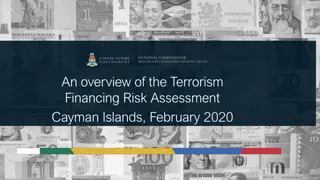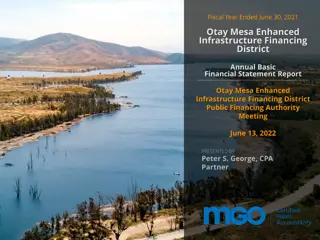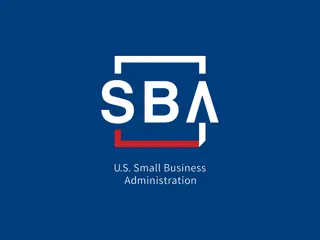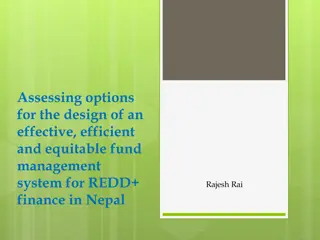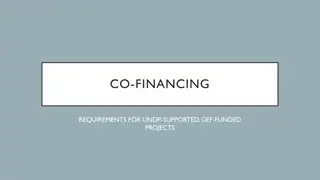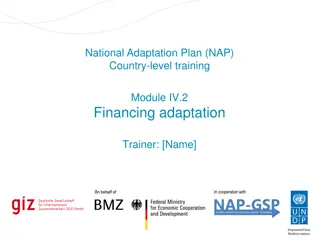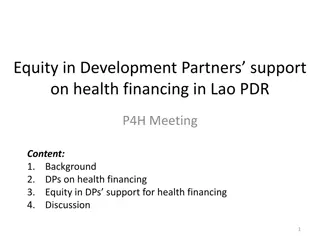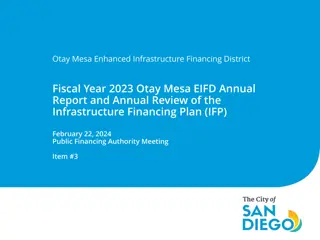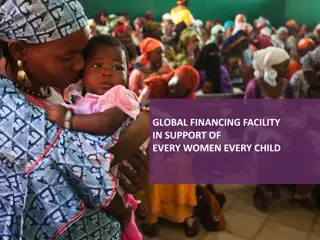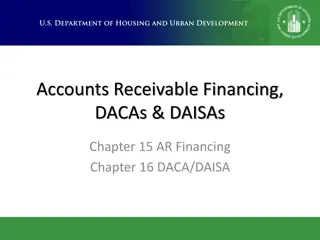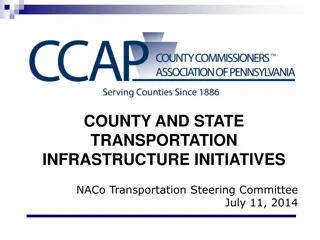Understanding Infrastructure Financing Options and Principles
This presentation discusses the various tools and principles of infrastructure financing, including project finance, corporate finance, public finance, and blended finance. It covers the differences between financing and funding in infrastructure provision, the challenges faced by infrastructure service providers in accessing private finance, and the role of credit enhancements and financial instruments. The content also delves into specific structures of public and corporate finance in infrastructure projects.
Download Presentation

Please find below an Image/Link to download the presentation.
The content on the website is provided AS IS for your information and personal use only. It may not be sold, licensed, or shared on other websites without obtaining consent from the author. Download presentation by click this link. If you encounter any issues during the download, it is possible that the publisher has removed the file from their server.
E N D
Presentation Transcript
Infrastructure Financing Presented by: Options OLOPADE Hakeem (Snr. Financial Advisor) March 2021
Outline 1. Basic Principles/Tools of Infrastructure Financing: Project/Structured Finance, Corporate Finance, Public Finance and Blended Finance 2. Understanding Infrastructure Financing Vs Funding Options 3. Infrastructure Financing Options 4. Credit Enhancements and Financial Instruments 5. Conclusions and Take-outs 2
Learning Objective 1. To understand basic principles behind Project & Structured Finance, Corporate Finance, Public Finance, and Blended Finance; 2. To understand the concept of Financing vis- -vis Funding in Infrastructure Provision; 3. To understand some of the challenges facing infrastructure service providers in accessing private finance 3
Basic Principles/Tools of Infrastructure Financing 1. Public/Government Finance: public sector lending, grants, subsidies or guarantees of indebtedness; may be least expensive, but may not be sustainable 2. Corporate Finance: financing to the project company or a sponsor company against proven credit risk and on-going business 3. Project Finance: limited or no recourse financing to a special purpose vehicle or company ( SPV or SPC ) - project company relying primarily on future cash flows of the project for repayment; more expensive than government financing but offbalance sheet 4. Private Finance: may employ Corporate and Project Finance to provide equity, quasi-equity, shareholders and subordinated loans, grants, etc. to develop projects 5. Blended Finance: Using grants and/or concessionary finance with commercial finance to reduce the cost of capital in delivering infrastructure thereby making tariffs affordable. All of the above are tools for Infrastructure Financing Options
Basic Principles/Tools of Infrastructure Financing Public Finance Structure A government borrows funds to finance an infrastructure project and gives a sovereign guarantee to lenders to repay all funds. Government may contribute its own equity in addition to the borrowed funds. Lenders analyse Government s total ability to raise funds through taxation and general public enterprise revenues, including new tariff revenue from the project. The sovereign guarantee shows up as a liability on Government s list of financial obligations. Source: Project Finance Manual, National Treasury South Africa 2001
Basic Principles/Tools of Infrastructure Financing Corporate Finance Structure A private company borrows funds to construct a new treatment facility and guarantees to repay lenders from its available operating income and its base of assets. The company may choose to contribute its own equity as well. In performing credit analysis, lenders look at the company s total income from operations, its stock of assets, and its existing liabilities. The loan shows up as a liability on the company s balance sheet ( Mining the Corporate Balance Sheet ) Source: Project Finance Manual, National Treasury South Africa 2001
Basic Principles/Tools of Infrastructure Financing Project and Structured Finance Structure A team or consortium of private firms establish a new project company to build, own and operate a specific infrastructure project. The new project company is capitalised with equity contributions from each of the sponsors. The project company borrows funds from lenders. The lenders look to the projected future revenue stream generated by the project and the project company s assets to repay all loans. The host country government may/may not provide a financial guarantee to lenders; sponsoring firms provide limited guarantees. Off- Balance-Sheet financing.* Source: Project Finance Manual, National Treasury South Africa 2001
Basic Principles/Tools of Infrastructure Financing Private Finance Structure Project Sponsor(s) after entering into collaborative structures with the Government may implement infrastructure projects through corporate and project financing tolls and also by providing: Equity; Quasi-equity; Grants; Debts (in Cash and in-kind); Subordinated or Shareholders debt; and Others. The Project Sponsor, prior to providing any and/or all of the aforementioned financing products to implement a project, would have executed relevant agreements with the Government or Entity saddled with the primary responsibility to provide that service to the public, before stepping into implement the project or to provide same service.
Basic Principles/Tools of Infrastructure Financing Blended Finance Structure Blended finance is the strategic use of development finance and grants to mobilize private capital flows to emerging and frontier markets, by mitigating risk and/or ensuring commercial risk adjusted returns. It has three characteristics: Use of development finance and effective partnerships to attract and mobilize private capital into development deals/projects Leverage Investments that drive social, environmental, and economic progress in line with local context for transparency and results Impact Financial returns for private investors in line with market expectations, based on real and perceived risks Returns 9 Source: OECD Blended Finance Principles, 2018
Basic Principles/Tools of Infrastructure Financing How Blended Finance Works Junior Equity Flexible Debt Market Rate Debt or Equity Guarantees Grants Funds activities that lead to investment costs and Subordinate position absorbs highest risk Favorable terms risk-return profile Investment on same terms demonstrates viability and provides investor comfort Risk Reduction tools that investors capital losses provide enhancement shift protect against or credit 10 Source: OECD Blended Finance Principles, 2018
Understanding Infrastructure Financing Vs Funding Options Infrastructure Funding refers, broadly, to revenue sources, often collected over a span of many years, which are used to pay the costs of providing infrastructure services. The most common sources of infrastructure funding are: General purpose tax revenues: Tax revenues for infrastructure can be raised from many sources; Revenues from user charges: Tariffs or User charges are typically tied directly to the cost of producing the service for which the fee is charged. This source of funding is limited, however, to those forms of infrastructure (such as toll roads) and related services that are amenable to the collection of user charges; and Other charges or fees dedicated to infrastructure: Transfers/Revenue from Government, from a variety of charges and fees can be applied to infrastructure funding, such a fuel surtaxes and vehicle registration fees. Infrastructure Financing - by contrast, turns these revenue sources into capital that can be used today to build or make improvements in infrastructure. Commons sources include: Concessional financing; Commercial financing; and Grants and others. Only if a project can demonstrate reasonable predictability in funding sources for both capital expenditures and for operations and maintenance (O&M) can issues such as financing and delivery be tackled successfully. In other words, unless infrastructure funding issue is addressed, the financing options will continue to be limited. Source: World Economic Forum Accelerating Infrastructure Delivery, New Evidence from International Financial Institutions (2014)
Understanding Infrastructure Financing Vs Funding Options Funding sources ( 3Ts ) Repayable financing Tariffs User fees for services provided and households investment for self-supply Concessional finance Provided by development agencies with a grant element (e.g. softloans ) Pre-finance Transfers Transfers from external sources, such as international donors (ODA grants), remittances Commercial finance Provided by private sector financiers at market rate (vendor finance, microfinance, loans, bonds, equity) Repay foundations, NGOs, Taxes Domestic taxes levied by local and central governments and provided as grants or subsidies or appropriation Key Private funds Mixed public and private funds Public funds Source: Sophie Tremolet,WBG 2017
Understanding Infrastructure Financing Vs Funding Options Characteristics Instruments offered Loans in more favorable terms compared to other sources. Important but insufficient Concessional loans Technical assistance Development Financial Institutions Working Capital Financing Commercial lending Short or long term Difficult to access if the utility/project is not creditworthy Commercial banks Financing Project or Infrastructure Asset has to repay its obligations Commercial Finance Difficult to access if the country does not have developed financial markets Fixed-income instruments Sales of Shares Financial markets Credit from supplier may only cover financing for specific investments Customer Advances Credit from supplier Other Sources Funding Project or Infrastructure Asset does not have to repay these amounts Transfers by government. Important but not sustainable in the long term. Government
Infrastructure Financing Options Government Financing and Funding Options Required On-budget Funding Off-budget Funding & Financing Infrastructure Spend Over the next 30years Primarily from Taxes, Transfers government revenue. Includes: Budgetary Allocation, Enhanced Statutory Allocation, Ecological Funds, etc Govt. assumes some financial commitments as is the case with Special Intervention Funds; Bonds; Low-interest concessional loans; Financing and funds from aid and donor agencies; Enhancements; Resources, Tariffs, etc Energy US$1Trillion; Transport US$775billion; Credit Minerals Water, Agric, Mining US$400billion; Funding & Financing Options Housing & Regional Devpt. US$350billion; Private Sector Financing and Funding Options ICT US$325billion; Funding and financing is sourced through means that may require minimal or no government contribution. Includes: PPPs, PFIs,, Leases, Mgt. Contract, etc with funds from Contractual Savings Sector, Long Term Commercial Bonds (Capital Markets), Multilateral Agencies, MDBs, Export Credit Finance, DFIs, Private Equity, Infrastructure Funds, DMBs, Pension Funds, etc. Repayment is usually through Tariffs, Transfers & Govt. Subsidies Social Infrastructure US$150billion i.e. $3 Triillion (30yrs) Source: NIIMP, 2015
Infrastructure Financing Options Spectrum of Public-Private Interactions Private Sector partially owns and operates Private Sector owns and operates Public Private Partnerships (Public Ownership eventually) Public Owned and Operated Sale of Public Assets Full divesture Consultants Concessions BOT, DBFO, etc. Projects Tenders for construction Service Contracts Management contracts Operating contracts Joint ventures Lease/ Affermage Restructuring Corporatization Decentralization Private Sector Involvement and Participation increases and Public Sector s Control and involvement Decreases. 15
Infrastructure Financing Options Benefits of PPPs Synergy 1+1=3 On time and on budget 16 Source: National Audit Office-UK Parliament- Expenditure Auditor
Infrastructure Financing Options Project Financing Allocation Guide Grants Concessionary finance Public finance VGF Commercial Finance/ Blended finance Financial unviable Unviable /economically viable Financial viable Financially Viable /economically viable Financially Marginally . Commercial finance Project & Structured finance Corporate finance Highly financially viable Own resources/ Grants Commercial finance Maintenance and operations 17
Infrastructure Financing Options Summary of Options for Private Sector Participation Limited risk transfer to private sector Substantial risk transfer Government control Full risk transfer No government control Government control Risk transferred contractually to private sector Full Divestiture Most common PPP modality Most common PPP model Concession Contract BOT 20-25-30 yrs PFI Delegation of management Lease Contract 5-15 yrs Management Contract 3-10 yrs Service Contract 1-3 yrs Technical Assistance As the contract duration increases, more risk can be allocated to private sector Contract Duration Source: adapted from IFC (2018) 18
Infrastructure Financing Options Government Funding and Financing Options Appropriation Acts and Annual budgetary subventions or allocations backed by Taxes and Natural Resources earnings; Statutory Allocations & Recoveries; Transfers and other Government charges; Sukuk Bond for Roads; EPC Contract + Financing; Ways and Means; Funds from Donor Agencies; and so on. Tariffs Government operated and managed projects to collect tolls, surcharges, etc. On Budget Funding Special Intervention Funds such as CBN Power & Aviation Fund, Real Sector Support Fund, National Gas Expansion Programme, etc; NSIA managed Presidential Infrastructure Development Fund and Infrastructure Fund; Presidential Intervention funds, etc Alternative Financing Mechanisms such as Road Infrastructure Development and Refurbishment Investment Tax Credit Scheme:Minerals for Infrastructure; and so on. Sovereign and Concessional Loans ranging from G2G Loans from Policy Financial Institutions and Development Banks, Development Finance Institutions, Export Credit Agencies and Banks, Multilateral Development Banks; other syndicated loans from International Financial Institutions; Local Development Bonds; Promissory Notes for Roads development; and so on. Credit Enhancement Instruments issued in alliance with MDBs such as Partial Credit Guarantees or PCI, Partial Risk Guarantees or PRI; Other Credit Enhancements such as Minimum Revenue Guarantees; Viability Gap Funding; Sovereign Debt Notes; Comfort Letters; Standby Letters of Credit; Project Preparation Funds; and so on. Need to e Off-Budget Funding and Financing 19
Infrastructure Financing Options Private Sector Funding and Financing Options Bilateral and Multilateral Agencies provides Aids, Grants and Technical Assistance to projects, sectors, private practitioners and other privately-led government agencies, to provide infrastructure across the project development and implementation value chain. Grants from Government to catalyze follow-on financing from private sector. Grant Funding Service Contracts, O&M Contracts Funds from Corporate and Private Finance through Deposit Money Banks, Private Capital, Mutual Funds, Equity, Commercial finance, etc Franchise Arrangements Funds through Project Finance, Corporate Finance & Private Capital License Arrangements Funds accessed through Project and Corporate Finance from DMBs, MDBs, Contractual Savings Sector, Corporate Bonds, etc Affermage and Lease Arrangement Funds through Corporate and Private Financing structures from DMBs, Private Equity, MDBs, Infrastructure Funds, and so on. Concessions all funds through Project Finance, Corporate Finance, Private Capital, and so on, accessed through MDBs, DFIs, Contractual Savings Sector, Donor Agencies, Private Equity, DMBs Joint Ventures utilise Project and Corporate Finance structures through DMBs, MDBs, Private Equity, Microfinance, Infrastructure Funds, Commercial finance,etc Privatization and Full Divesture Corporate and Project Finance, accessed through MDBs, DMBs, International Financial Institutions, DFIs, Contractual Savings Sector, Private Equity, and so on Public-Private Interactions or Partnerships 20
Infrastructure Financing Options Uses of Commercial Finance by Borrower size & Financing Need Large Bonds MDBs Others Commercial Bank Loans Medium Vendor/ Supplier Finance Microfinance Small Households Medium sized entrepreneurs Utilities/Govt. Municipalities Small scale providers Communities Size of borrowers 21 Source: Sophie Tremolet,WBG /UNICEF 2017
Infrastructure Financing Options Success Factors for attracting Private Sector Ensuring Government Commitment All necessary parties of the Government supportive and aligned. The Government providing sufficient bankable financial support. Ability of the government to support projects due to fiscal constraints. Good regulatory framework. Regulatory framework can be implemented quickly and efficiently. Private investors can recover their investment in worst case scenario. Legal/Regulatory Framework All risks are allocated to the party best placed to manage them. Need to develop a balanced risk allocation matrix. The Government should bear the risks that private sector is not capable of. Appropriate Risk Allocation Technical and financial capacities and capabilities with verifiable track record The sponsor will be able to collect payment for services. Need to evaluate ability of government vs. users to pay. Sponsor Quality Source: IFC (2018) 18
Credit Enhancements & Financial Instruments Making Markets Work Adding resources to enable financial sustainability Reducing risks to financiers Subsidy or VGF X There are a wide range of tools available to facilitate commercial finance . Equity Grant or Blended Finance X X Project Preparation Funds X Microfinance X Guarantee Political Risk Insurance + Partial Risk Guarantees X Tenor Extensions X Pooled Finance X Hedging Instruments X Intercepts X Credit ratings X Benchmarking X 23
Credit Enhancements & Financial Instruments Govt. Catalysing Private Capital into Infrastructure Provision Others - Cash Backing, ISPO, SBLC, SGs, etc Project Minimum Revenue Guarantee Revolving Facility Political Risk Insurance/ Guarantee (PRG/PRI) Categorization & Attendant Instruments Project Preparation & Development Funds* Viability Gap Funding (VGF) Socio-Political Infrastructure Projects Conditionally Viable Infrastructure Projects Viable Infrastructure Projects Project categorization will be further evaluated based on Objectively Verifiable Indicators and attendant Credit Enhancement Instruments issued, based on project commercial, financial and economic viability metrics *Whilst PPDF may not be classified as a direct Credit enhancement instrument, it unlocks private capital into Infrastructure Projects 24
Credit Enhancements & Financial Instruments Unlocking Contractual Savings Sector Funds for Infrastructure Bankable PPP Projects Strategic Partnerships with Developers and FGN procurement and Regulatory Agencies FGN & MDAs Contractual Savings Sector, MDBs, DFIs, etc (US$100b) Credit Enhancement Instruments Projects of Critical National Importance can be made bankable by the FGN through incentives and Credit Enhancements issued by the FMFBNP, to meet the funding and financing metrics of Contractual Savings Sector, DFIs and other Financiers. 25
Credit Enhancements & Financial Instruments Unlocking Private Funds for Infrastructure 26
Conclusions and Take Outs Accessing Contractual Savings and DFI Funds - Contractual Savings (Pension Funds) South-Africa, Singapore and Chile have been able to work out a commensurate risk-return structure that's been used to access pension funds for infrastructure development An effective approach that Nigeria may use to channel pension fund contributions into large scale infrastructure projects without compromising the current widely praised system would be for PFAs to be mandated to invest into specific bankable projects, already pre-approved by an FGN appointed independent Infrastructure Development Firm or independently resourced and managed PPP Centre Taking a cue from Singapore s mandatory savings model and Chile Infrastructure Bond approach, the FGN could credit enhance Infrastructure bonds directly linked to bankable infrastructure assets - that PFAs will subscribe to, in line with the PENCOM Act. The scheme has to be completely transparent and robustly regulated to prevent high-level abuses and reduce the likelihood of fraud. MDBs, DFIs, ECAs, etc Government to work with these local and international financial institutions to credit enhance projects to attain Investment Grade status thereby unlocking funds for infrastructure development FGN to institutionalise the National Credit Enhancement Framework to include VGF Scheme, Minimum Revenue Guarantees, Termination Guarantees, and other incentives; capitalise the Project Preparation Facility with Seed Funds; MDBs, DFIs and other local and International Financial Institutions will be a part of the Project Preparation Facility to generate critical mass of investors and financiers; and Work with MDBs, DFIs, ECAs to issue PRGs or PRIs, PCGs or PCIs, and other credit enhancement instruments Government to improve on funding (3Ts) sources structures - Public Investment and Finance Management - to be able to attract Infrastructure Financing from Private sector practitioners
and Finally Useful resources 29
Useful resources 1. Project Finance - Introductory Manual on Project Finance for Managers of PPP Projects - Version 1 National Treasury/PPP Manual; 2. World Economic Forum - Accelerating Infrastructure Delivery New Evidence from International Financial Institutions, 2014; 3. Easing the Transition to Commercial Finance for Sustainable Water and Sanitation -August 2017 - Amanda Goksu, Sophie Tre molet, Joel Kolker, and Bill Kingdom; and 4. International Institute for Sustainable Development Credit Enhancements for Green Projects - Promoting credit-enhanced financing from multilateral development banks for green infrastructure financing, Madhu Aravamuthan, with Marina Ruete and Carlos Dominguez May 2015. 31






